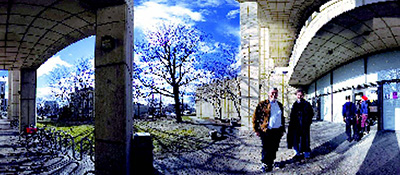A couple of years ago architectural history professor Dietrich Neumann learned a bit of magic. He’d long admired the intricately painted panoramas that were popular in the nineteenth century, and a colleague, Ed Huff, who is the multimedia guru for Brown’s visual art department, showed Neumann how he could make panoramas on the computer with an ordinary digital camera. Not only that, the images could be shown through QuickTime, making them virtually four dimensional and fully interactive.
Neumann was hooked. He travels frequently, and he began photographing as he went, capturing on film the buildings he was lecturing about and then electronically stitching those images together so that his students, sitting in the darkened List auditorium, had the experience of swirling and zooming through the spaces he was discussing.

Last November, he showed students a panorama of Chicago’s Rookery Building, in which the camera seemed to pan around the cavernous stone lobby, soar up the stone stairwell, and zoom in on the balcony railings and light fixtures designed by Frank Lloyd Wright in a 1905 renovation. You’d have sworn you were looking at video.
Demonstrating the technology on his office laptop in January, Neumann opened a nighttime shot of the Chicago Tribune Building that he was preparing to use in a lecture later that week in Rotterdam, at the opening of an exhibition he curated on the architecture of the night—the subject of his most recent book. Moving around the image with the mouse, Neumann used the shift key to zoom in on the golden lights at the top of the building. (It was built by Raymond Hood ’02, “one of the great skyscraper architects of the 1920s,” Neumann says.) Then he backed off and spun around to examine the Wrigley Building across the street, which was illuminated by a pale green light. “I think it’s supposed to make you think of spearmint,” he said, noting that “These two buildings speak to each other”—a point that the panorama made seamlessly.
Huff had been making digital panoramas on his own, and he taught Neumann how to use public domain software called PTgui, which is basically a souped-up, three-dimensional version of the photo-stitching programs that come with many digital cameras. The process involves shooting a series of still shots, while rotating the camera in a complete circle. Using software, Neumann merges the images to create the sides of the panorama and then attaches images that form the top and bottom. From the viewer’s perspective, the result feels like looking around the inside of a cube or some other geometric form.
Neumann and Huff applied to the president’s office for a technology grant and subsequently bought a digital camera, a pair of tripods, and lenses (they most often use a 10.5 mm lens). Huff’s Web site, www.brightridge.com/360.html, includes a dozen or so panoramas of the Brown campus.
Panoramas are now a staple in Neumann’s classes. He thinks he’s the only art professor in the world to use them so regularly, but he aims to change that. This spring he’s using the technology at Yale, where he is teaching architecture students as the Vincent Scully Visiting Professor of Art. He plans to make his panoramas available to the public through an image-exchange project run by the Society of Architectural Historians (www.sah.org), during his upcoming term as the organization’s president.
“This technology has really changed my life,” says Neumann, grinning a little impishly. He shrugs. “My luggage is much heavier.”
—Charlotte Bruce Harvey ’78




